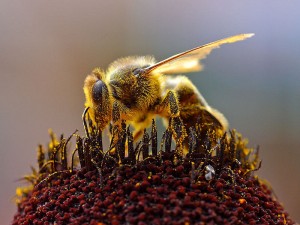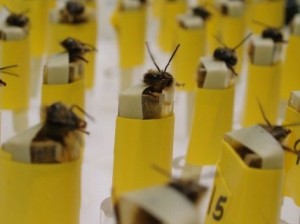 I thought I’d made the case against parasitic wasps with evidence and eloquence. I thought that would be the end of it. But no: counter-arguments were made (even if insects did evolve first, Josie, I can still feel superior), gauntlets thrown down, aspersions cast (you think I didn’t notice “delicate flower,” Heather?), and lines drawn in the sand. I decided I must defend those of us revolted by the moral tendencies of insects. I began by googling bees. Before I could find anything about killer bees or maybe the horrors of the hive-mind, I got diverted.
I thought I’d made the case against parasitic wasps with evidence and eloquence. I thought that would be the end of it. But no: counter-arguments were made (even if insects did evolve first, Josie, I can still feel superior), gauntlets thrown down, aspersions cast (you think I didn’t notice “delicate flower,” Heather?), and lines drawn in the sand. I decided I must defend those of us revolted by the moral tendencies of insects. I began by googling bees. Before I could find anything about killer bees or maybe the horrors of the hive-mind, I got diverted.
Bees have antennas that are highly sensitive to the molecules of scent. They’re also trainable. Creative minds in the military-industrial-governmental-academic complex were inspired to train bees to detect various vapors – narcotics, bioterror threats, explosives in buried landmines or hidden bombs.
Bees were trained, their flight patterns were followed with a radar-like technology, and they flew straight to most of the planted landmines. Encouraged, the creative minds set up the Stealthy Insect Sensor Program. Bees are given, say TNT vapor, then sugar water until at the smell of TNT, they stick out their little tongues. This is called the Proboscis Extension Reflex, or PER. A bee who’s good at PER-ing is harnessed on top of a little bee-sized cylinder, its body and wings covered by the harness, head and antenna and a couple legs sticking out and waving around. Several of these harnessed bees are put into a “detection platform,” meaning a box like an egg carton, and the box is held over some suspect device and the bees inside are recorded on camera, PER-ing. A video shows observers saying “Oooooh! Wow!”
Bees are self-reproducing, portable, cheap, each trainable in minutes, and sensitive to parts per trillion, as good as dogs and better than some lab instruments. It’s true that harnessed bees last only a couple of days, so a company that manufactures a 36-bee, six-cassette detection platform that looks like a hand-held vacuum cleaner apparently unharnesses them on a shorter time scale and returns them to the hive “where they happily live out the rest of their lives.” The whole enterprise is so promising that the research is now classified.
And having learned all this, I found I admired the bees for their God-given talents and their endurance and pluck while in forced bondage. That and now I find out that Josie, in her book, Buzz, already included these bomb-sniffing bees as evidence for her side. So ok. I’m still not giving in. But in the intra-blog-fight over the revoltingness of insects, I seem to have scored an own goal. Worse yet, if anything is mildly appalling around here, it’s not the bees.
Photo credits:
bee on flower: Jon Sullivan
bees in harnesses: Los Alamos National Laboratory